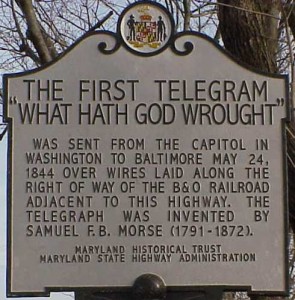By Bruce Doorly
Beginning in 1858, for only a month, then permanently in 1868, a transatlantic telegraph cable extended 2000 miles across the ocean floor linking the continents. This seemed remarkable to me that this era had such communication. Thus, I set out to write this article about the telegraph.
Throughout history almost all communication would take days, weeks, or even months for one place to receive often vital information from another place. Exceptions were few and limited – carrier pigeons, fires, and signal towers.
A tragedy in his life made him realize that mankind needed a faster method of communication. Years before while he was traveling alone, his wife had unexpectedly died at home. He had been writing her letters when she had already passed away. While he learned of her death when he was still on the road, it was weeks later, so he had missed her funeral. This experience stayed with him.
After years of study, along with his assistant Alfred Vail, he devised a system where coded electrical impulses representing letters could be transmitted many miles across wires and be recognized by a receiver on the other end. This was a formidable task as electricity and the wires that carried them were a new technology.
Importantly, he devised a simple code for the letters known as the Morse Code. His electrical impulses were just of two types – a short one known as a “dot” and a longer one known as a “dash.” A unique combination of the two made up each letter.

The first demo of the telegraph by Samuel Morse was at the Speedwell Ironworks in Morristown NJ in 1838. (His assistant’s father owned the business.) The building where this demo was held, as well as many of the other buildings in that complex, have been preserved. A museum worthy of a trip is there today. The banner as you enter the property simply says “Historic Speedwell – Birthplace of the Telegraph.”
For the first demo, Morse and Vail, set up two miles of wire throughout the property. Their first message was the strange “A patient waiter is no loser.” Initially, only the local newspapers took notice.

Later that year they would demo the telegraph in Washington to President Martin Van Buren.
After obtaining a patent and lobbying the U.S. Congress, Morse and Vail were granted funding in 1843 for a telegraph line to be laid from Washington to Baltimore - a distance of 40 miles.
In May of 1844, the telegraph line was ready. In a much-publicized demo, the first message "What hath God wrought!" (a quote from the bible) was transmitted. With the message traveling 40 miles in seconds, the revolutionary potential of the telegraph became apparent.
At the time, the telegraph, with the near instantaneous communication that it allowed, was considered the greatest invention in the history of mankind.
Starting in 1845 many telegraph lines and telegraph offices were constructed. By 1846 a line from Philadelphia to Fort Lee (north east NJ) was operational. This line had telegraph offices not just at the starting and ending destinations, but Norristown, Doylestown, Somerville, and Newark.
In October of 1847 another telegraph line was completed across New Jersey. This line started in Trenton, had offices in Princeton and New Brunswick, ending in Jersey City. This route was built the same year as the train line that went between these same towns. Thus, a marriage between the railroad lines and the telegraph lines had begun.
there was an office in Somerville

By 1850 about 12,000 miles of lines from 20 companies existed in the United States. But by 1864, Western Union had consolidated these many companies into one and would have 90% of the telegraph market for the next 50 years. The public benefited from the telegraph daily through the newspapers who could now report the news immediately from any place.
Secondarily, the public could benefit by sending messages called Telegrams to family and friends for a fee. The receiving office would then dispatch messengers and deliver the message right to the home. But only an estimated 2% of the population sent telegrams in any given year. Because telegrams charged by the word, messages were short. It was businesses that often used the telegraph.
In October of 1861, the first transcontinental telegraph line across the United States was completed.
In 1858, the next great expansion of the telegraph was attempted. In 1851, an underwater cable had been installed and was operational 20 miles across the English Channel connecting England to France. In 1853, England had connected 50 miles underwater to Ireland. But these were short distances compared to the 2000 miles needed to cross the Atlantic Ocean. The locations chosen were Newfoundland, Canada and Valentia Island, Ireland as that was the shortest route.
Led by Cyrus Field, in 1858, a transatlantic telegraph line was completed resulting in a tremendous public celebration, but this line worked only for a month before shutting down for good.
Then in 1866, an improved telegraph cable was laid that was operational for years. By 1880 four other cables were laid successfully across the Atlantic Ocean.

Locally the surviving Polk’s business directories from 1917 through the 1930s list a Western Union Telegraph office at the train station depots of Somerville and Raritan. The Raritan office closed sometime in the mid-1930s. The Somerville Western Union office was open as late as the 1980s.
But starting in the late 1930s telegrams and other information was no longer sent by telegraph. Radio towers and other modern methods had replaced the telegraph – and the era of the telegraph quietly faded into obscurity.
Abbreviations are:
S-Somerville, B.B-Bound Brook, and R-Raritan